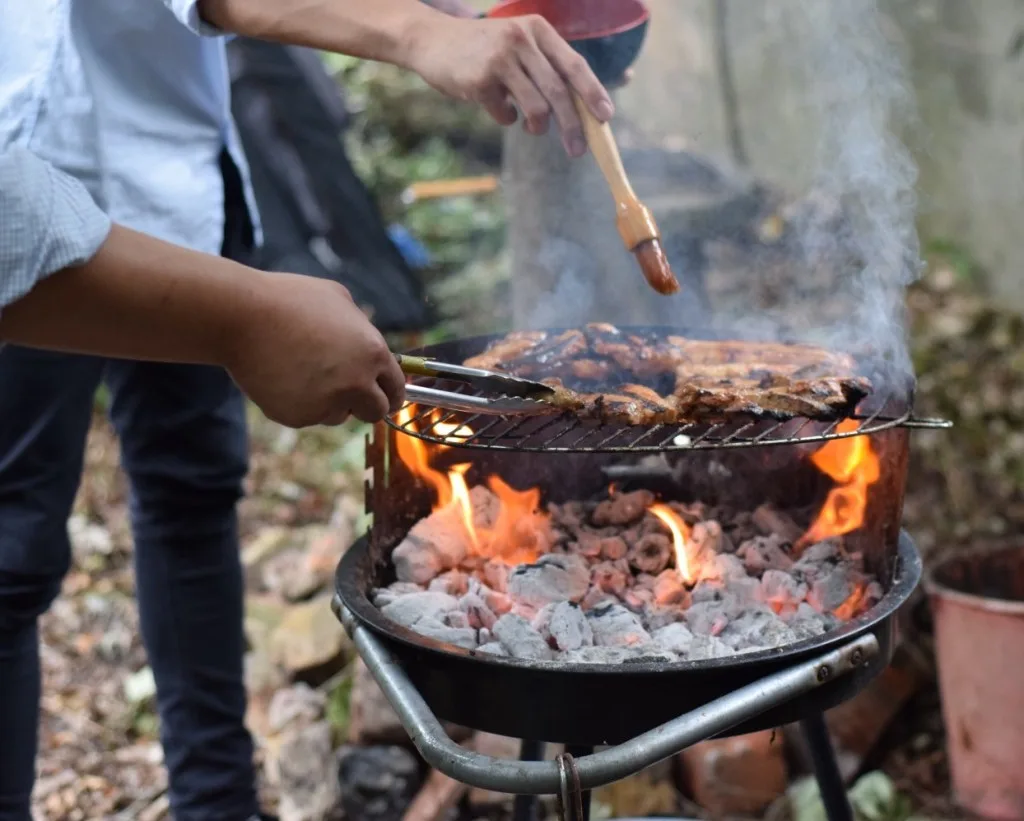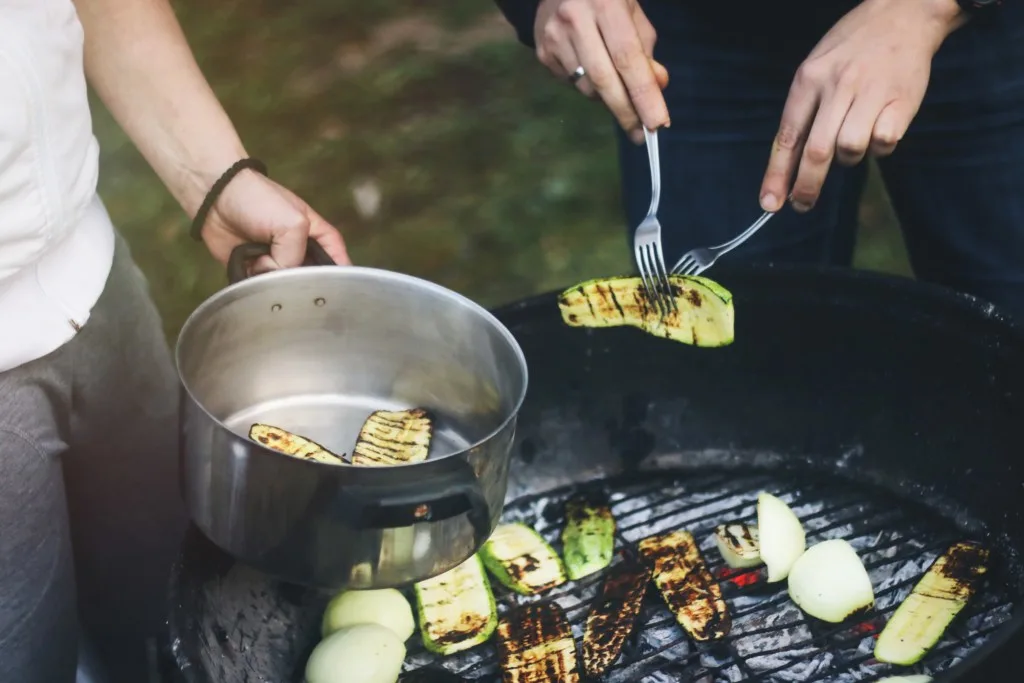Should Campers Use Lump Charcoal or Briquettes When Grilling
Lump charcoal is becoming a popular option to help grillmasters create delicious food on the grill.
Grilling season will be here before you know it, and grillmasters will use any product that ups their game. So, we’re taking a look at this growing trend in the grilling community.
Let’s dig in!
What Is Lump Charcoal?
Lump charcoal is a natural option gaining popularity among grillmasters and other BBQ enthusiasts. Manufacturers use kilns to heat pieces of wood from sawmills, branches, and other sources in a closed environment. The wood gets charred, but the wood doesn’t ignite due to a lack of oxygen.
Lump charcoal not only costs more than other options but also burns faster. Because this type of charcoal can reach incredibly high temperatures, it’s an excellent option for searing steak or grilling chicken wings.
However, it’s not a perfect option for items requiring low temperatures for extended times.

What Are the Benefits of Lump Charcoal?
If you’re considering giving lump charcoal a try, let’s look at a handful of the benefits you can expect.
Easy to Adjust Temperature
You’ll quickly discover that lump charcoal responds more to oxygen than typical briquettes. If your grill has adjustable air vents, you can easily open or close them to raise and lower the temperature.
Having control of the temperature is essential for perfect grilling. This style of charcoal can give you that control and create the ideal grilling environment for that perfect steak or ribs.

Less Ash to Clean Up
One of the worst things about grilling is the mess it creates. When you choose lump charcoal instead of briquettes, you’ll have very little ash left behind. Less ash means less hassle, especially when you might not be camping somewhere where you can easily dispose of the ash.
No Additives
Using lump charcoal that’s all-natural means no additives or chemicals in the wood. That helps avoid a chemical aftertaste from things like lighter fluid.
Many individuals are choosing organic and attempting to be healthier. Using this heat source while grilling can help you avoid cooking your food over chemicals. If you’re a fan of pure and natural-tasting food, these lumps may be a great option for the next time you’re grilling.
Lump Charcoal Burns Hotter
Lump charcoal burns at incredibly hot temperatures, much higher than typical briquette options. This assists greatly with searing a steak or other flavor-filled cuts of meat. Searing a steak caramelizes natural sugars on the outside of the meat. This caramelization creates a brown crust on the surface of the meat for a much more savory meal.

What Are the Downsides of Lump Charcoal?
While there are many benefits to using lump charcoal, you should be aware of the downsides as well.
Lump Charcoal Burns Faster
This type of charcoal naturally burns much faster than alternative heat sources. The faster burning may not be a problem if you’re cooking something quickly. However, items that require a long cooking time can be painful. You’ll likely find yourself feeding pieces into your grill to keep the temperature up and the fire going.
Pieces Are Uneven
Because there’s no uniform shape or size to many pieces during the drying process, they char unevenly. This irregularity often results in uneven temperatures throughout the grill. As a result, getting consistent heat throughout the entire grilling surface can prove frustrating.
Lump Charcoal is More Expensive
Not only does this charcoal burn faster, but it’s also more expensive. Using lump charcoal can make an already expensive night of grilling even more costly as you shovel more and more of the quick-burning pieces into your grill.
A 20-pound bag of lump charcoal can cost $45 to $70. Keep in mind that because this charcoal burns faster, you’ll be using more of it as well. It’s easy to see how this can quickly add up.
What Are Charcoal Briquettes?
Much like lump charcoal, charcoal briquettes use sawdust and other leftover wood materials. These materials are heated in a controlled environment to prevent them from igniting. Where charcoal separates itself from lump charcoal is that there are additives used during the process. The additives are there to help with the shaping of the briquettes to make them easier for stacking. There are also additives used to make lighting the charcoal quick and easy.
Charcoal briquettes are the traditional charcoal that campers and grillmasters have been using for years. They’re relatively easy to use and a much cheaper option.
What Are the Benefits of Briquettes?
Briquettes are one of the most popular types of grilling fuel. Let’s take a look at a few of the benefits.
Steady Temperatures
Because of how briquettes are shaped and put together, there’s a consistency in how they burn. A steady and even temperature is key when grilling. You won’t have large hot spots as the briquettes burn.
Cheap
One of the best features of charcoal briquettes is that they’re insanely cheap. You can pick up a couple of bags for less than $20 at your local big box store. These briquettes are often available year-round, but the best prices will be during the peak grilling season, which is summer.

Burns for a Long Time
Another benefit of choosing briquettes is that they burn for an incredibly long time. They’re able to burn for approximately an hour. This long-lasting formula means they’ll go the distance for the slow and low items you’ll be grilling. As a result, you won’t have to shovel in briquettes as often as you will the lump charcoal.
What Are the Downsides of Briquettes?
As many generations of grillmasters know, briquettes aren’t perfect. Let’s look at a few of the downsides.
Lots of Ash
When briquettes finish burning, they leave behind a lot of ash. While additive-free briquette ash is great for adding to gardens, you can’t use the ash from briquettes with additives.
With so much ash left behind, you’ll need to find a way to dispose of it while camping. You don’t want to toss it on the ground and leave behind a mess. The best way to properly dispose of this ash is to let it cool completely and dump it onto aluminum foil. Then, you can crumple up the aluminum foil and throw that all in the trash.
Takes a While to Light
If you’ve ever grilled using briquettes, you know nothing about it is fast. Therefore, you’ll need to plan for when you want to start cooking. These briquettes can take 10 to 15 minutes before they’re ready for cooking. Then, once the entire exterior is an ashy color, you can begin cooking.
Smells Like Chemicals
One of the least appealing things about briquettes is the chemical smell that they emit. Many people can’t stand the smell and also say they can taste it on their food. It can make some people lose their appetite.
Should You Use Lump Charcoal or Briquettes?
When it comes to lump charcoal or briquettes, it boils down to preference. Many campers like the smell and taste of meat cooked over traditional briquettes. However, others are disgusted by the same smell and taste and couldn’t imagine using anything other than lump charcoal. If you can afford the increased price of lump charcoal and desire the purest taste, it’s a great option for your next cookout.
Cooking out on the grill brings people together. Cookouts are great for making memories and growing relationships. There’s something about the teamwork involved with everyone pitching in to create a massive meal that forges a bond. So which will you choose for your next cookout?
Discover the Best Free Camping Across the USA
To be honest with you, we hate paying for camping. There are so many free campsites in America (with complete privacy).
You should give it a try!
As a matter of fact, these free campsites are yours. Every time you pay federal taxes, you’re contributing to these lands.
Become a FREE CAMPING INSIDER and join the 100,000 campers who love to score the best site!
We’ll send you the 50 Best Free Campsites in the USA (one per state). Access the list by submitting your email below:
I don’t know where you came up with the ridiculous cost difference between lump charcoal versus briquettes as I’ve never seen such dramatic differences in price. In fact, I have often seen lump charcoal to be the less expensive option, unless you’re strictly comparing “super premium” lump charcoal to the most inexpensive briquettes. Most people would refer to that as an apples to oranges comparison. What many people don’t realize is that most brands of charcoal briquettes, even those that say 100% natural, contain coal and are not just wood charcoal. Coal is a 100% natural product! The addition of coal is one reason for the longer burn time and more ash as well as the chemical smell or flavor they can give the food. It is also why they are sometimes cheaper. Only those that state they are 100% wood are really simply wood charcoal. If it doesn’t state that on the bag it most likely has coal in the briquettes. Coal ash has many toxic chemicals in it! Using the match light types also adds far more chemical fumes and flavor to the food as they are soaked with far more lighter fluid than most people ever use to light their charcoal and it continues to send chemical fumes long after the flames it produces when light subside. It is always best to use a charcoal chimney to start either type and avoid the match light type! The choice of which type to use and how to start it is a personal one. Both take about the same amount of time to be ready to start cooking once lit regardless of how you choose to light them.